With two days until the release of the Nintendo Switch 2, all eyes are on Kyoto. Eight years after the original Switch achieved a historic milestone with sales of 152 million units, it is time for succession. This anticipated, scrutinized, and especially critical succession comes with a risk: history shows that following a peak can lead to significant declines, as seen with the failures of both the Wii and Wii U, each selling around 13 million units. Aware of this risk, Nintendo opts for continuity by naming the new console simply “Switch 2.” There are no additional designations like “Super,” “Plus,” or “Pro” that might confuse consumers in retail environments such as Carrefour. The name is clear and straightforward to avoid any ambiguity. However, some may feel that the packaging resembles the first version too closely, which I see as a readability issue, but we will leave it at that. To support this release, Nintendo reveals its trump card: Mario Kart World. This long-awaited sequel has been in development for eleven years since the last true entry, Mario Kart 8 on Wii U in 2014 and its Deluxe version on Switch in 2017. The result of these games is impressive, with a total of 77 million copies sold. Launching the Switch 2 alongside a new Mario Kart is not just a choice; it is an obvious necessity given no other game has such widespread appeal. After several hours of play, here are my observations.
Since its inception, the Mario Kart series has consistently established itself as an indispensable reference in racing games, blending speed, fun, and chaotic competitions on closed circuits. With Mario Kart World, however, Nintendo takes an unprecedented step by introducing for the first time an open world, or more accurately described by Nintendo as interconnected regions, where players can literally drive anywhere, even on water. There are thus no map restrictions; the player enjoys complete freedom! This novelty clearly disrupts established norms and redefines the Mario Kart experience, shifting from previous entries that were confined to closed circuits to one that invites exploration. It’s no longer just about competing on a specific track but freely traversing diverse landscapes, sometimes connecting several linked circuits via roads that become integral parts of the races themselves. So, rest assured, there are still loop tracks in Mario Kart World, but the major innovation is composing your own track to compete against up to 24 participants.
For instance, in the ‘Race VS’ mode, after selecting your character, car, and cubic centimeters, you can choose the circuits. You have the option to select ‘Lap’ for racing in loops or opt for the new feature, ‘At Your Discretion,’ which allows you to pick your starting and arrival tracks. Once on the map, you start by choosing a circuit as your starting point and then selecting an arrival circuit from there. For example, you might choose Chutes Cheep Cheep as the starting point, with subsequent options such as Mushroom Cave, Observatory Peak, DK Mountain, Wario’s Cargo Ship, Salt Flower City, etc. The route varies in length based on each track’s position on the map, and an automatic transitional trace connects each biome, allowing transitions from urban worlds to Japanese-inspired settings, African savannahs, more urban environments, lush jungles, or even flying to reach sky circuits—this variety is quite remarkable. This diversity is precisely what makes Mario Kart World so powerful: the feeling that you never race the same course twice. Given the numerous tracks and vast open world, possibilities are multiplied from the start, with no two routes resembling each other. Although it’s unlikely we will exhaust every possibility immediately upon release, initially, there is an overwhelming variety. Considering Nintendo’s history of enriching content through DLCs, this sensation of great diversity can be sustained over time. Additionally, Mario Kart World introduces a day-night cycle and dynamic weather for the first time, resulting in a 24-minute day with atmospheric changes. The sky alters, sudden rain falls, sometimes triggered by the Lightning item, adding visual chaos to the mix.
Mode Knock Out: Karting Battle Royale Style
One of the standout features of Mario Kart World is undoubtedly its Knock Out mode, also referred to as Survival mode or VF. This innovative mode involves consecutive marathon races with strategic checkpoints and eliminations at each stage. If a player does not achieve a high enough ranking, they are eliminated from the race and can only observe the remaining competitors through the camera. In addition to regular opponents, players must also avoid various hazards such as vehicles launching Bob-omb projectiles or unexpected disruptors like the Mart brothers, who create obstacles on the track themselves. The pressure is constant throughout, with tracks defined by specific rally points: Turbo Rally, Ice Rally, Moon Rally, Spike Rally, Cherry Rally, Chestnut Rally, Cloud Rally, and Heart Rally. Each marathon consists of six circuits, and in multiplayer mode, the choice of track is determined by a vote among players. This leads to explosive, exhilarating, and thoroughly enjoyable races.
In Mario Kart World, players can observe expansive track widths that are notably broader than in previous games, which is necessary given the game’s capacity for up to 24 players simultaneously. However, the game also features instances where paths narrow and obstacles block the way to enhance the racing experience. Another key aspect of Mario Kart World is its faster pace; after a player incurs a penalty, collides with an obstacle, gets overtaken, or falls into the void, they are quickly returned to the track. This maintains the game’s excitement, ensuring that races conclude rapidly and keeping the gameplay engaging throughout.
24 Players Simultaneously: Controlled Chaos
Another advantage of having wider circuits that give the impression of allowing freedom anywhere desired is the ability to experiment with level design. Thanks to a charged jump executed by holding the jump button without specifying a direction, players can perform higher jumps, enabling them to leap onto edges found throughout tracks. This allows for sliding on rails, dodging attacks, or even jumping onto walls temporarily and accessing initially inaccessible areas. Chaining these jumps opens up secret paths and shortcuts.
There is also a new feature I would like to highlight, which revolves around food in the game Mario Kart World. This element serves as a central theme within the game. Throughout the circuits, you will encounter small paper bags containing plates inspired by each region of the world. These are placed at drive-ins called “Yoshi’s,” which can be found nearly everywhere on the map. Each Yoshi’s location is designed to match its environment: for instance, a Yoshi’s in a volcanic area will resemble a volcano and offer smoking soup inspired by Bowser. Beyond their visual appeal, these dishes serve a gameplay purpose as they provide boosts and help unlock various costumes throughout the game. These costumes are purely cosmetic enhancements with no additional gameplay effects.
THE WALK OF HAPPY PEOPLE
Now we will move on to the Tour mode, which is accessible at any time during the game and allows players unrestricted access to the entire open world. In practice, Nintendo promises hundreds of secondary missions to complete in what could be called a hub waiting area between two Grand Prix events. I have not had the opportunity to test this extensively yet, but I hope it is more than just an empty world where one can develop their driving skills without the stress of competition, but with limited content and superficiality. I certainly expect Nintendo to address these potential gaps and ensure that the mode offers more engaging activities beyond simply chatting and taking selfies with friends.
Technically, the game is highly stable and runs smoothly at 60fps without any interruptions. This was already evident in Mario Kart 8 Deluxe, but with the addition of 4K visuals in docked mode, support for up to 24 participants, and numerous visual effects, it could have easily overwhelmed the system. However, the game handles these enhancements well. In split-screen mode, however, the frame rate drops to 30fps, which is noticeable but still acceptable. Additionally, a camera feature was tested that allows players to display their faces on the track in a Mario Kart Arcade fashion. This feature is quite cool, even though it sometimes obstructs the view.
Have any thoughts?
Share your reaction or leave a quick response — we’d love to hear what you think!



